Canon EOS R7 vs Canon EOS R10: which mirrorless camera should you buy?
Which of Canon's affordable mirrorless maestros is for you?
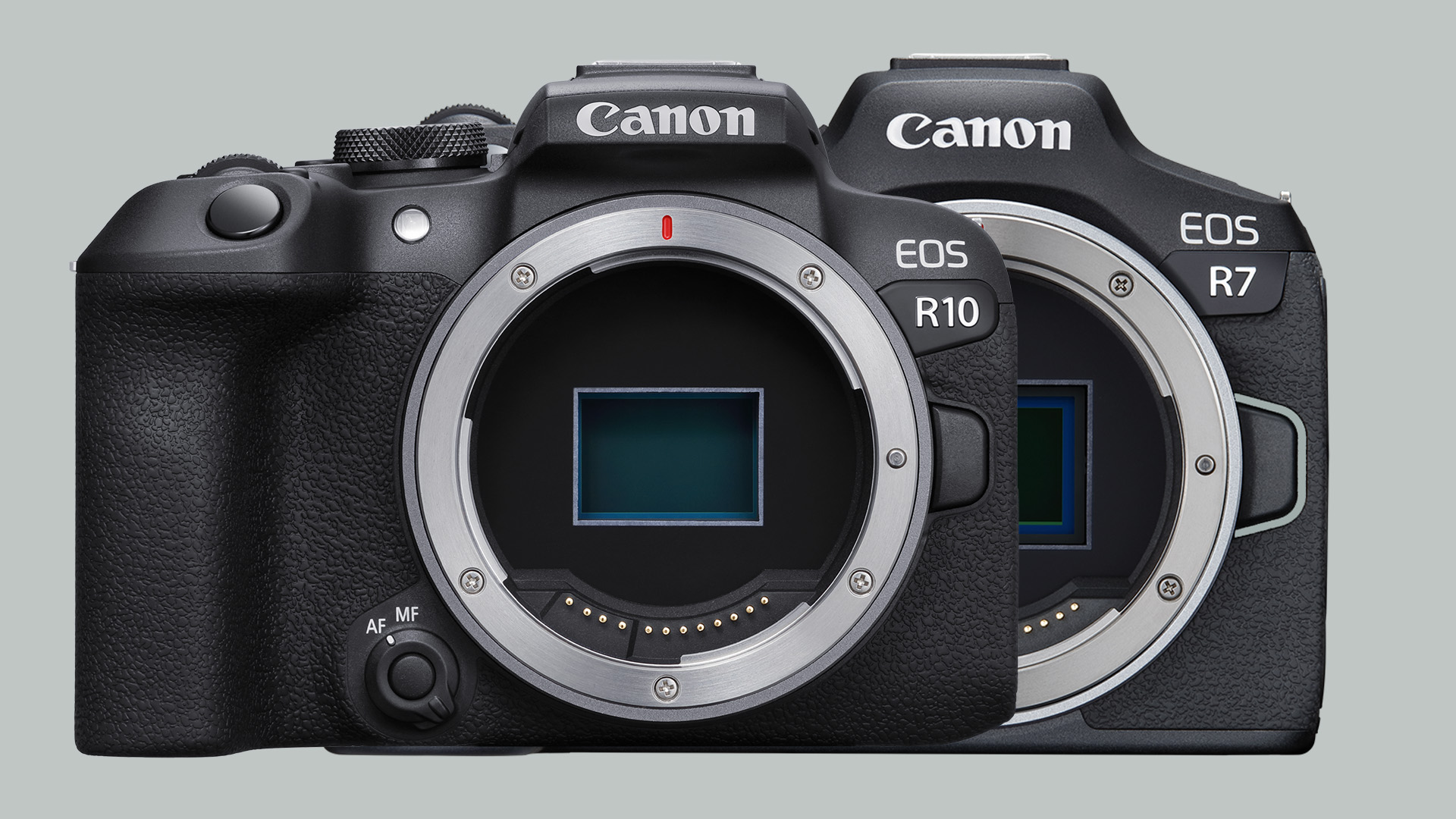
The Canon EOS R7 and Canon EOS R10 are both APS-C mirrorless cameras that look quite similar from a distance, but their prices place them in completely different categories.
Canon’s EOS R7 costs $1499 / £1349 / AU$2349, the EOS R10 $979 / £899/ AU$1499 (both body-only). In other words, the R7 is 1.5x the price of its more basic sibling.
In a world of rising camera prices, neither is catastrophically expensive. They’re RF-mount follow-ups to cameras like the Canon EOS M6 Mark II and the classic EOS 7D, and naturally have modern features that those older models lack, most notably Canon's latest autofocus system.
Is the EOS R7 worth the extra outlay? For many photographers, it probably is. There's unlikely to be a world-changing disparity between the two cameras' image quality in many scenarios, and both have excellent burst speeds. But the EOS R7 nets you IBIS (in-body image stabilization), crop-free 4K/60p video, a Log image profile and much better battery life, among other extras. You can read more about these in our in-depth Canon EOS R7 review.
That said, the Canon EOS R10 is the obvious choice for those who would prefer a smaller, lighter camera or – just as importantly – don’t have the money to spend on extra enthusiast-level features. We've put together our early impressions in our hands-on Canon EOS R10 review, which concludes that the camera certainly punches above its weight.
Here's a closer look at how they compare in all the crucial areas so you can decide which mirrorless cameras is the best for you.
Canon EOS R7 vs Canon EOS R10: design
- The EOS R10 is smaller, but less rugged
The bodies of the Canon EOS R7 and Canon EOS R10 fit into familiar strata. One is a reasonably light, moderately sized APS-C camera – that's the EOS R10.
Canon’s EOS R7 is a larger, heavier camera that balances better with larger, longer lenses. Weight is the disparity that stands out best on paper.
The Canon EOS R7 weighs 612g with a battery and SD card, 42% higher than the 429g of the EOS R10. Dimension differences sound less dramatic, at 132 x 90.4 x 91.7mm versus 122.5 x 87.8 x 83.4mm. However, hold them one after the other and the shift in size is unmistakable.
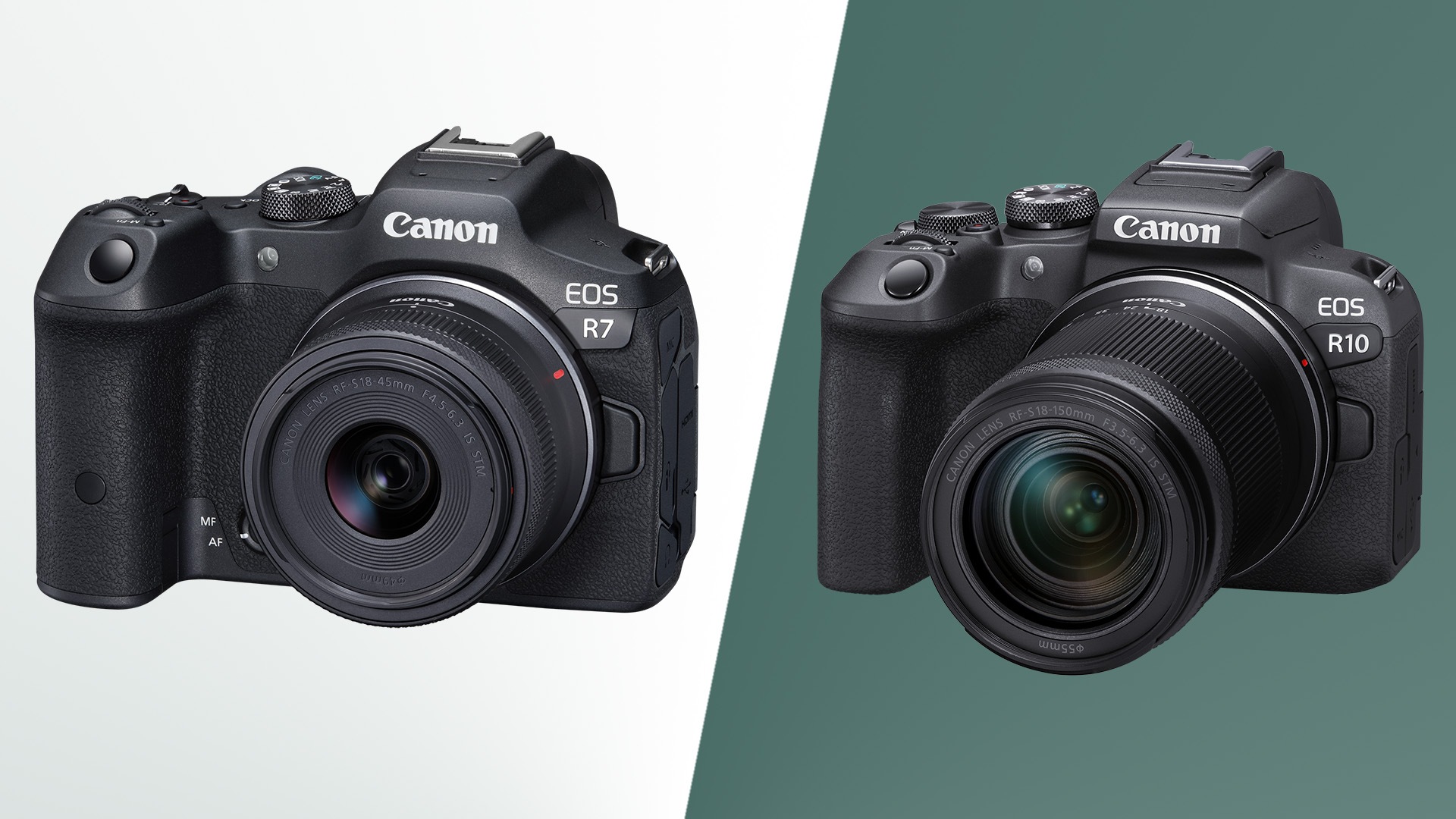
If you’re looking for a light camera onto which you might put a street photography-ready pancake lens, the EOS R10 will likely suit your needs better.
There is another benefit to the Canon EOS R7’s outer design, though. It has better weather-proofing than the EOS R10 (similar to the Canon EOS 90D). As is always the case with cameras, we have no concrete claims or specs to back up the exact water resistance in each, but Canon has assured us the EOS R7’s water and dust resistance are superior.
Again, it’s a classic characteristic of a lower end-higher end camera divide. Let’s not do the Canon EOS R10 down, though. Both cameras have a magnesium inner shell and at least some degree of weatherproofing.
There’s also a slight difference in their controls. The Canon EOS R7 has a rotary dial on the back by the viewfinder, instead of up top, and the power switch has a third position that takes you straight to the video mode.
Canon EOS R7 vs Canon EOS R10: sensor
- Higher pixel count EOS R7 bring more focus points
Both the EOS R7 and EOS R10 are APS-C cameras. This means their low-light performance won't be quite as impressive as a full-frame model, but APS-C sensors are still highly versatile. The Canon EOS R7 has a significantly higher-resolution sensor, though, at 32.5MP, compared to the EOS R10’s 25.5MP.
This will make the Canon EOS R7 better for post-shoot crops, and for blowing up images to large prints. However, the difference is not as vast as we see in some other ranges. Sony’s A7 series varies from 12MP to 61MP.
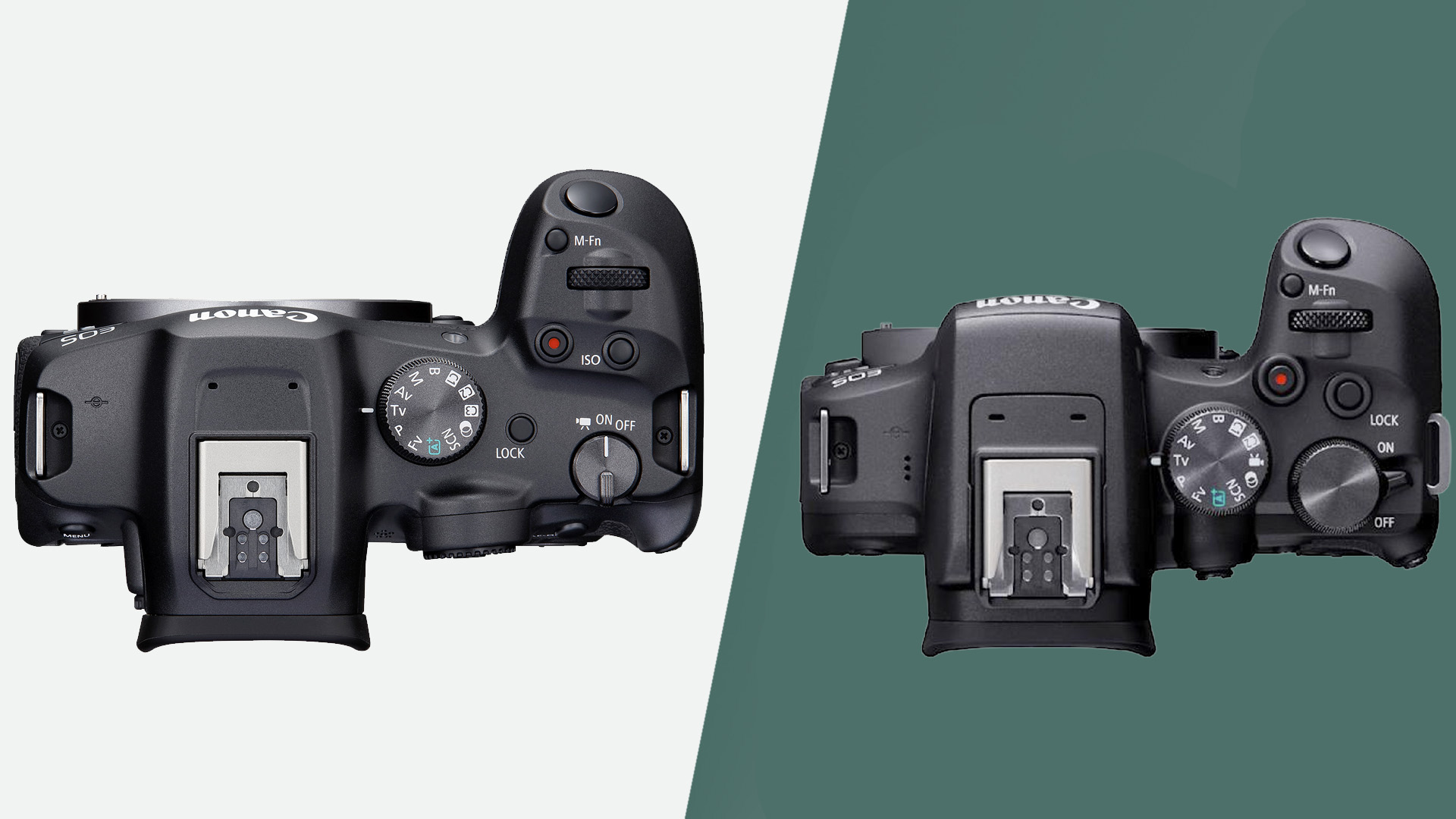
Higher resolution also reduces the size of a camera’s sensor pixels but, again, the disparity here isn’t enough to worry about too much. Both cameras have a native ISO range of 100-32000, with an extended 51200 mode.
The Canon EOS R7’s higher pixel count also has the knock-on effect of increasing the number of focus points. These cameras have PDAF (phase-detection autofocus) points built into the sensor. There are up to 5,915 selectable points in the EOS R7, 4,503 in the EOS R10.
This doesn’t really affect the experience, though. The two cameras share the same Dual Pixel CMOS AF II focusing system, and both get 651 points when using autofocus.
Canon EOS R7 vs Canon EOS R10: performance
- The Canon EOS R7 has (mostly) better burst shooting
The Canon EOS R7 has the edge for burst shooting, although both cameras top out at 15fps with the mechanical shutter. They separate when you switch to the electronic shutter. The EOS R7 can reach 30fps, the EOS R10 23fps.
That slower mechanical shutter speed is more than fast enough for most people, but the way the Canon EOS R7 pulls ahead will be important to action and sports photographers. It also lends credibility to this higher-end model, matching monster mirrorless cameras like the Sony A1 (in terms of outright speed, at least).
The Canon EOS R7 also has a better burst buffer than the EOS R10, at least in most shooting situations. At 30fps, it can record 42 raw files (126 JPEG) before needing to flush out the buffer, compared to 21 raw frames (70 JPG) in the EOS R10 at 23fps – double the number.
| Row 0 - Cell 0 | Max burst speed (mechanical shutter)) | Buffer (mechanical shutter) | Max burst speed (electronic shutter) | Buffer (electronic shutter) |
| Canon EOS R7 | 15fps | 224 JPEG / 51 raw images | 30fps | 126 JPEG / 42 raw images |
| Canon EOS R10 | 15fps | 460 JPEG / 29 raw images | 23fps | 70 JPEG / 21 raw images |
Shooting at 15fps muddies the situation a little. Raw burst is, again, almost twice as good in the EOS R7. The buffer lasts 51 exposures to the EOS R10’s 29.
However, when capturing JPEGs the lower-end camera performs better. The Canon EOS R10 can hold on for 460 frames before slowing down, to the EOS R7’s 224 frames.
This suggests the Canon EOS R10 hits a sweet spot at 15fps where its ability to purge the buffer is almost in harmony with the data rate. You can thank the camera’s lower resolution, although 223 frames at 15fps still means you can hold the Canon EOS R7 shutter button down for 15 seconds before the buffer is exhausted. That's more than enough for most shooting scenarios.
Canon EOS R7 vs Canon EOS R10: features
- The Canon EOS R7 is a little more versatile, and has IBIS
The Canon EOS R7 is slightly faster than the EOS R10 in some respects, despite sharing the same processor, and this bleeds into the minimum exposure time, too.
The EOS R7’s fastest shutter speed with the mechanical shutter is 1/8000, to the 1/4000 of the EOS R10. Both can reach 1/16000 of a second with the electronic shutter, but the added mechanical shutter speed is again an asset for action photographers.
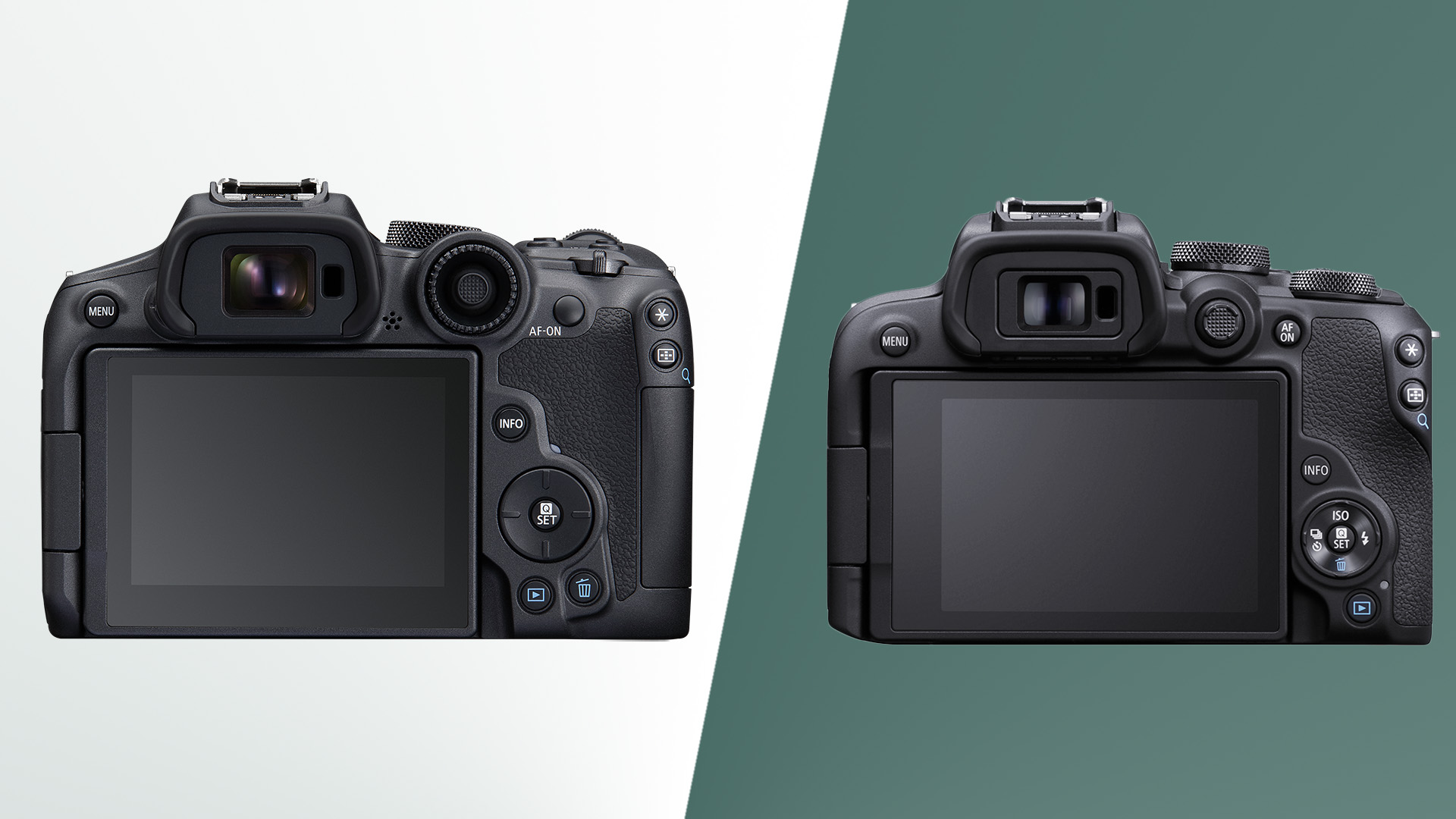
In-body image stabilization (IBIS) is likely to be a bigger draw for the rest of us. The Canon EOS R7 has it, the EOS R10 does not.
This will make the R7 much better for handheld night photography, particularly when using a lens without its own stabilization (IS). Results will improve with or without lens IS, though. Canon calls the IBIS “collaborative”, meaning it can operate in tandem with lens stabilization.
Canon EOS R7 vs Canon EOS R10: display and EVF
- The Canon EOS R7 has a slightly better screen and EVF
At first glance, the rear screen and EVF of the EOS R7 and EOS R10 look similar. They both have fully articulated 2.95-inch rear displays capable of refresh rates up to 120Hz. Their EVFs are low-mid range 2.39-million-dot resolution models, equivalent to 1024 x 768 pixels.
In both cases, these are a solid fit for the price. However, there are some differences.
The Canon EOS R7’s rear display is a little higher-res than the EOS R10’s, at 1.62-million dots to 1.04-million dots. In pixel-speak, that’s 900 x 600 pixels versus 720 x 480 pixels.
EVF magnification is bigger in the EOS R7 too, meaning the image seen through the viewfinder will appear larger. That is good news for real-world clarity, making composition a little easier.
Canon EOS R7 vs Canon EOS R10: video
- The Canon EOS R7 has much better “pro” style video features
While both of these cameras provide the basics of a satisfying video experience, including 4K capture at 60 frames per second, 120fps at Full HD and even optional in-camera 10-bit 4:2:2 color capture, the EOS R7 has a couple of clear advantages.
The one everyone will notice, even light-use hobbyists, is that the Canon EOS R7 can shoot at 4K/60p without cropping into the image. To shoot 4K/60p on the R10 you have to put up with a 64% crop.
Why is this the case when they both have the Canon DIGIC X sensor, and these limits are largely about the processing required? Our best guess is that when you halve the native resolution of the Canon EOS E7, you end up with a resolution that's pretty close to 4K, so there’s less work for the processor to do.
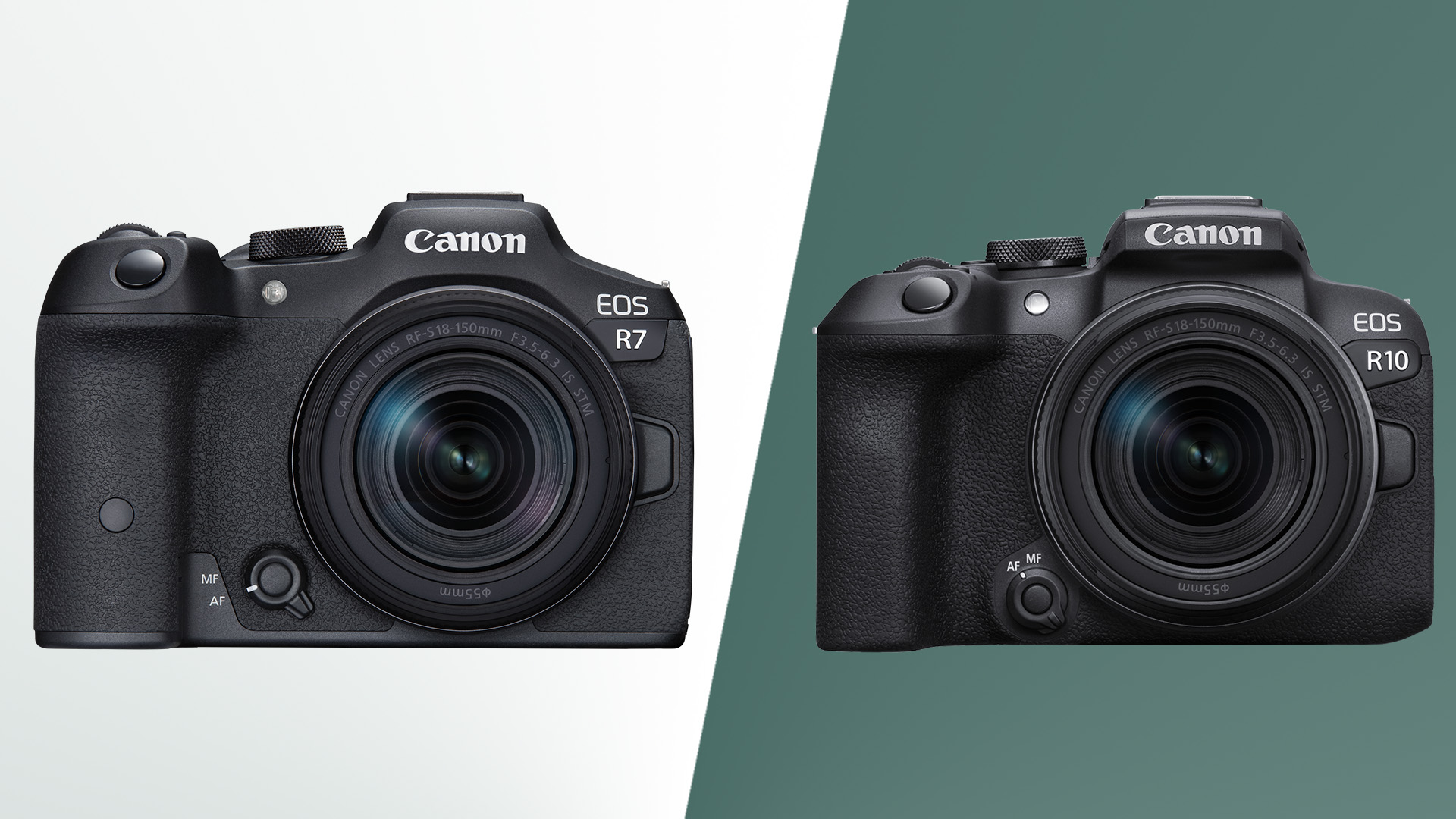
For the best image quality you’ll want to use the 4K “fine” mode in each case. This restricts both cameras to 30fps capture but creates the final image using all the relevant sensor pixels, with a process called 'supersampling' or 'oversampling'.
The wealth of pixels lets the camera smooth out hard edges and diagonals without loss of detail.
Canon’s EOS R7 also has a Log mode, Canon Log 3, that's missing from the EOS R10. This is a classic 'flat' shooting style that's designed to preserve maximum dynamic range, for those who want to color grade their footage properly after taking it.
This is a critical part of the EOS R7’s identity as a serious hobbyist camera that can skip between multiple fields – street photography, action photography, video shoots and more.
Canon EOS R7 vs Canon EOS R10: storage
- EOS R10 has a slower USB connector, just the one SD card slot
Neither of these cameras are necessarily high-end enough to justify a CFexpress card slot and, sure enough, they don’t support either the Type-A or Type-B CFexpress standards. But you can use SD cards right up to the UHS-II speed class.
However, the Canon EOS R7 gets two slots, the EOS R7 just one. None of the modes appear to require dual cards, just a fast enough single SD card, so the benefit is all about being able to be able to capture more stills and video without worrying about storage.
You are less likely to want or need to remove a card when transferring files too, as the Canon EOS R7 has a fast USB 3.2 Gen 2 interface. This means it is theoretically capable of throughput of up to 10Gbit/s, equivalent to 1250MB per second.
The Canon EOS R10 has a USB 2.0 interface, which taps out at just 480Mbit/s or 60MB/s. Buy an ultra-fast memory card for the camera and you won’t see its top transfer speeds when moving images over a cable.
Canon EOS R7 vs Canon EOS R10: battery life
- They have different batteries, with the EOS R7's having double the capacity
The Canon EOS R10 uses the 1,040mAh LP-E17 battery, shared with cameras like the EOS RP and EOS M6 Mark II. The Canon EOS R7 includes the larger, more expensive and higher-capacity 2,130mAh LP-E6NH.
It has more than double the capacity, and delivers almost double the frames per charge. It’s CIPA-rated for 770 shots using the LCD display, or 500 with the viewfinder. That’s a lot better than the respective 430 and 260 shots of the EOS R10. The latter in particular may feel quite restrictive.
Of course, the LP-E6NH would not be a good fit for the Canon EOS R10, being a lot larger and almost double the weight of the LP-E17.
Verdict
The Canon EOS R7 and EOS R10 have a lot in common, but the differences show they are made for separate audiences. The Canon EOS R10 is an approachable, high-quality camera for those who want to take their photography beyond the smartphone, or that compact camera they’ve owned for years. It’s an approachable way into the RF lens mount system.
Its 4K/60p video keeps it up-to-date enough, the body isn't too heavy, burst shooting of up to 23fps is impressive, and the 25.5MP resolution is going to be enough for fairly large prints.

The Canon EOS R7 offers important upgrades in almost every area, though. IBIS may add bulk to the body but will be a big bonus for those who want to shoot handheld with compact non-IS lenses. It can shoot 4K video at 60 frames per second without a crop, there’s a pro-style Log mode and battery life is almost twice that of the Canon EOS R10.
Sure, the EOS R7 may not be intended for pros who demand the added dynamic range and low-light performance of a full-frame sensor, but it seems a perfect fit for the demanding hobbyist.
Get daily insight, inspiration and deals in your inbox
Sign up for breaking news, reviews, opinion, top tech deals, and more.
Andrew is a freelance journalist and has been writing and editing for some of the UK's top tech and lifestyle publications including TrustedReviews, Stuff, T3, TechRadar, Lifehacker and others.
